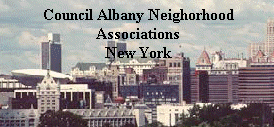Andrew Papale likes his
neighborhood so much, he bought the empty lot next door to his
house and is building his dream home on it.
That's the way it is in the Pine Hills section of Albany. Many
people, renters and homeowners included, live there for a
lifetime, or as long as a job will allow.
"My wife and I moved from Guilderland, because we wanted
to be where there are sidewalks and to have stores within
walking distance," says Papale, an Albany native who works
for the state Office of General Services.
Shopping and restaurants are abundant along the commercial
sections of the neighborhood, which include Albany's busy
Madison, Western and Washington avenues. The area also includes
a post office, a police station, a library branch and banks and
medical offices.
Kim Penman has lived in the neighborhood since 1980, and when
she married six years ago, she and her husband, Paul, moved into
a house just a few blocks from her parents' home.
"My goal is to live within walking distance of
CVS," laughs Penman, a special education teacher at Albany
High School. "I like being able to walk to places. You can
put your child in a stroller and walk to do errands."
Fresh air and shade
Pine Hills, which includes 87 blocks bounded by Washington,
North and South Lake, Woodlawn, and South and North avenues,
began to develop at the end of the 19th century. At the time,
Albany's well-to-do were leaving the grit of the city in search
of fresh air, shade, lawns and detached houses.
Law partners Louis Pratt and Gaylord Logan bought two large
farms and subdivided them into 50-by-200-foot lots that sold for
$1,200 each. In addition, the lawyers and developers planted the
conifers from which the neighborhood took its name.
Housing styles vary greatly in the area and include
Victorian, Colonial and cottage-style structures. Wrap-around
porches are just as common as the high banks many of the houses
are perched on.
"In this neighborhood, you don't feel like you are
living in the city.," says Penman. "You see and hear
the birds.
Although their lot is small, the Penmans have managed to
squeeze in amenities of suburban living, including a hot tub,
above-ground pool and a large deck. "It doesn't get any
better in the city," she says.
More than a century after it began, Pine Hills continues to
grow. Although available land is scarce, when it does come on
the market, it's snapped up for new construction. Currently
there are four new houses going up on West Lawrence Avenue.
As Albany's government and industry grew, the neighborhood
became more and more of an urban setting with more urban
problems.
"As a child, I used to go sledding on a lot of these
hills, before houses went in," says resident Steve Herubin.
"My parents live here also, and we have seen an increase
in crime," Herubin explains, saying most incidents include
breaking into houses and cars. "And a lot of times,
teenagers walk around late at night yelling and making other
noise and littering."
Other residents say traffic travels too fast on the
residential streets, and the quality of the schools is another
issue that concerns parents.
"Our daughter goes to Holy Names, because we were
worried about the safety of the public schools," said
Papale.
College presence
Several blocks of the neighborhood, largely between Morris
Street and Western Avenue, are occupied by the College of Saint
Rose, founded in 1920. In addition to building new facilities,
the college has purchased many older homes and converted them
into dorms and offices, and The University at Albany has its
downtown dorms in the same area. As a result, the neighborhood
also includes a significant student population.
At more than 100 years old, Pine Hills is a vibrant, funky
and diverse neighborhood that includes a cross-section of ages,
incomes and ethnicities.
At a glance
Real estate values: Approximately $87,000 to $450,000.
Schools: Schools 16 and 19, plus enrollments to other
elementary schools by lottery admission. Grades 7-8 attend
Philip Livingston Magnet Academy and Hackett Junior High, grades
9-12 attend Albany High School. Regents diplomas are awarded to
40 percent of graduates.
Taxes: Properties are assessed at full value. City and county
taxes are $14.75 per $1,000; school taxes are $20.78 per $1,000;
there is a library tax of $1 per $1,000. Taxes on a home valued
at $125,000 would be about $4,566.
Frances Ingraham Heins can be reached at 454-5502, or at
fingraham@timesunion.com.
